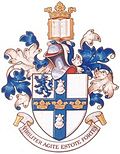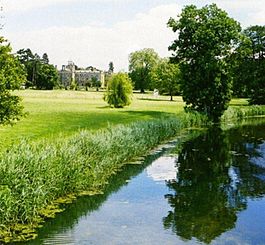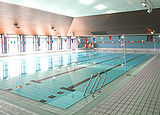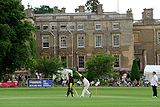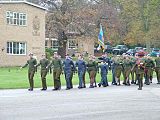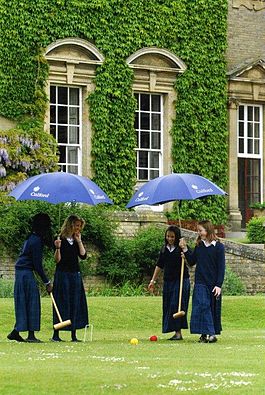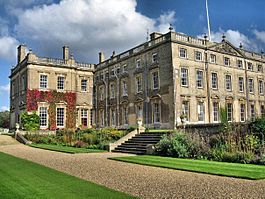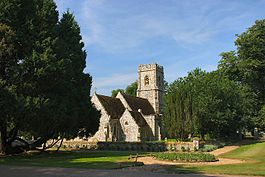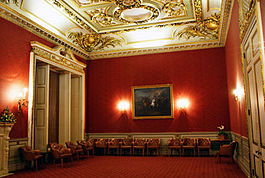- Culford School
-
Coordinates: 52°5′43″N 1°18′23″E / 52.09528°N 1.30639°E
Culford School Motto Viriliter Agite Estote Fortes (Quit Ye Like Men, Be Strong) Established 1881 Type Public School, Boarding and Day School Religion Methodist Headmaster J F Johnson-Munday MA MBA Chairman of Governors Prof. R Swanston Hon DSc FRICS FCMI Founder Dr. J. H. L. Christien Location Bury St Edmunds
Suffolk
EnglandStaff 100 Students 674 Gender Co-educational Ages 3–18 Colours Publication The Culfordian Former pupils Old Culfordians Website www.culford.co.uk Culford School is a coeducational HMC and IAPS public school (including Preparatory and Pre-Preparatory Schools) for pupils age 3–18. Founded in 1881, it is situated in Culford, four miles north of Bury St Edmunds in Suffolk, England.
History
The school was founded as the East Anglian School for Boys, incorporating an institution founded in 1873 by Congregationalist minister, Dr John H. L. Christien. It was one of a group of Methodist schools established in response to the growth of the middle class, the launching of the Woodard Schools and the 1867 Taunton Commission, which fuelled an expansion of secondary education in general and of non-conformist boarding schools in particular. The original school was in Northgate Street in Bury St Edmunds, but in 1886 it moved to Thingoe Hill in the town (a site later occupied by the East Anglian School for Girls).
In 1935 the school moved to Culford Park, former home of the 7th Earl Cadogan, and thereafter became known as Culford School. It is at the centre of East Anglia, c.90 minutes from London, 60 from Norwich, 40 from Ipswich, and c.30 minutes from Cambridge.
The school sits in 480 acres (1.9 km2) of Repton parkland with grazing, formal gardens, lake, and the 16th-18th Century Culford Hall. Originally the Hall became dormitories and classrooms; the laundry the sanatorium; the forge the art and woodwork studios (now the Pringle Centre for Design Technology); and the stables the Junior Department (now the Preparatory School).
The first new building to be added was Cadogan House, for junior boys, in 1938. The Leigh Memorial Swimming Pool was built in the same year. The Skinner and Hastings buildings were added in the 1960s, followed during the 1970s-1990s by an auditorium, pre-prep school, medical centre and biology laboratories. Purpose-built boarding houses and the Ashby Dining Hall (named after the then Chairman of the Governors) were constructed in 1972.
1972 was the year in which Culford amalgamated with its sister school, the East Anglian School for Girls (EASG), becoming one of the first co-educational HMC schools. New Houses were formed as follows:
Edwards House Senior Boys (named after G. S. Edwards, French & hockey master, Deputy Headmaster 1923-1962) Cornwallis House Senior Boys (named after the Marquis Cornwallis of Culford Hall) Jocelyn House Senior Girls (name transferred from EASG) Storey House Sixth Form Co-educational House - closed 2003 (named after Dr C. Storey, Headmaster 1951-1971) Robson House Senior Day Boys - formed 1993 (named after D. Robson, Headmaster 1971-1992) Fitzgerald House Originally Junior Girls - Senior Day Girls since 2003 (name transferred from EASG) Cadogan House Junior School - later Prep School – Boys; Girls since 1996 (named after Earl Cadogan) The school today
Culford is a selective school accepting pupils from a broad ability range. Half of the senior pupils are boarders. Three schools are housed within the Park:
- Pre-Prep (Fieldgate House) is for day boys and girls from the ages of 3 - 7. Founded in 1984, it is set on the village side of Culford Park. The current headmistress is Mrs Sarah Preston.
- The Preparatory School is a boarding and day school for pupils aged 8 – 13. It occupies the north of the Park, surrounded by its own pitches, but also uses Senior facilities. The present headmaster is Mr Mike Schofield, formerly a Senior housemaster. Upper 3 (year 8) entry to the Senior School is by Common Entrance.
- The Senior School is also a mixed boarding and day school, for ages 13 – 18. The houses overlook parkland and pitches, with academic pursuits centred upon Culford Hall and the newer buildings. Pupils join from UK and overseas prep and maintained schools; scholarships, exhibitions, bursaries, Forces allowances and Methodist Schools assistance[1] are offered.
The ten thousand volume Library is an oak panelled room overlooking Culford Hall’s south front, completed for the visit of King Edward VII in December 1904. The Centenary Hall, containing a Studio Theatre opened in 2006 by HRH the Duke of Gloucester (twenty five years after his first visit for the school's centenary), is also within the main building.
The Culford Foundation has raised funds for a new Pre-Prep nursery and dining hall; an astro-turf; the William Miller Science Centre (built in 2002 following a £1m donation by an Old Culfordian); and the restoration of Culford Hall. The Foundation also maintains the Old Culfordians association.
Culford is a Christian Methodist foundation, and the Church supports the school[2] whilst accepting pupils of all faiths and none. There are nine acts of weekday worship plus Sunday services at St Mary's church - pupils who so wish are confirmed jointly as Methodists and Anglicans. The Chaplaincy provides compulsory chaplaincy studies until the Fifth Form (Year 11): a new Chaplaincy Centre opened in 2008.
A November 2008 inspection report by the Independent Schools Inspectorate (ISI) states that the school is “outstanding” at the spiritual, moral, social and cultural development of pupils; in the quality of its pastoral care and boarding provision; and in its community links and its governance and management. The quality of the educational experience provided, and pupils’ learning and achievements, are “good, with many outstanding features;” and teaching is “good, and in a high proportion of lessons it is outstanding”.[3] A parallel Ofsted report rated boarding provision as outstanding;[4] and the Nursery, for children aged 3–4, was rated outstanding in every area by Ofsted inspectors in June 2008.
Academia
The ISI and the Good Schools Guide[5] state that the school performs well given the range of pupils’ abilities (corresponding to the top 60 per cent of the national range). Recent results include 53% of A-Level grades at A* or A in 2011; and 61% of GCSE grades at A* or A in 2009.[6] Generally c.10 per cent of the Upper Sixth go to Oxbridge. Culford has been amongst those schools commenting on the narrowness of league tables,[7] but it appears in the same range as rivals in the east of England.[8]
There is a Scholars Programme,[9] plus societies including for English, Art History and Medicine. Lecturers in 2009-11 include Sir Andrew Motion, Ann Widdecombe, George Alagiah and Henry Olonga.
A Sixth Form Enrichment Programme[10] offers Open University degree modules and pupils also compete in competitions such as the Intermediate Mathematical Challenge. Like many independent schools, Culford teaches the IGCSE[11] and in 2010, all of the pupils who took IGCSE mathematics a year early achieved A* or A grades. The Good Schools Guide claims that Culford has one of the six best maths departments in the country.
The school teaches pupils with special educational needs and for whom English is an additional language. Latin lessons are offered to pupils from local maintained schools. The pupil/staff ratio is approximately 1:10.[12]
The arts
The arts are co-ordinated by a Head of Art; Directors of Music and Drama; Heads of Strings, Wind and Brass; regular peripatetic music staff; and sometime Artists and Dramatists in Residence. Lamda qualifications are offered as are dance lessons. Culford has around twelve musical groups including two orchestras, a Choral Society, Chamber Choir, Wind Band, Jazz Band and Rock Society. Over half of the pupils learn an instrument. Boys from the Prep School may become choristers at St Edmundsbury Cathedral. Inter-house music competitions and termly concerts are held: recent concerts include Mendelssohn’s Elijah and Britten’s Noye's Fludde at the church in Orford where it was performed originally.
String and Wind Days are held for preparatory schools and the Suffolk Youth Orchestra is a regular visitor. Two major dramatic productions are staged each year, one musical and one stage play. Smaller productions are staged more regularly, including during House drama competitions. The Studio Theatre, the 400-seat Centenary Hall, and the Regency Theatre Royal are used as venues.
2009 saw the restoration of the west wing of Culford Hall to create the Beech Centre for Music and Performing Arts (part-funded by Old Culfordian David Beech). A recording studio in the cellars is to follow.
Recently The Daily Telegraph ran an article on drama at three schools including Culford Prep;[13] and Old Culfordian and BBC Producer Jon Jacobs re-visited the Music School to film for the The Proms.[14]
Sport and activities
The major competitive sports are rugby, cricket and particularly hockey, supplemented by tennis, netball and swimming. Regional honours are achieved whilst European and England players and champions in hockey, tennis, horse riding, karate, polo and rugby are on the school roll. Pupils compete in events such as the National Schools Rugby Sevens, and the Inter-Schools Hunter Trials.
Numbered amongst current Old Culfordians are an Olympic horserider, a British modern pentathlon champion,[15] a Welsh hockey international, and club rugby and cricket players for Richmond and Middlesex respectively. Previous generations of Old Culfordians have included several hockey players for England and one for Scotland, a captain of the Welsh team, and a Great British hockey Olympian; as well as an England badminton player.[16] The school has also produced numerous Oxford and Cambridge Blues.
In addition to the major sports, Culford offers a wide range of other sports and activities utilising its 480 acres (1.9 km2) of parkland and extensive facilities.
- List of facilities
*A sports centre (built in the 1990s) with 25m indoor swimming pool, sports hall with 4-lane cricket nets, bowling machine, squash courts, fitness suite, aerobics and dance studio, video assessment suite, and a climbing wall *Floodlit astroturf *Six rugby and five grass hockey pitches *A 4-court indoor tennis centre[17] *Six grass, six hard and six astroturf tennis courts *Three cricket pitches including cricket square with thatched pavilion, views of the Hall and Park, and grass nets *A lake, used for fishing, canoeing and punting, bordering Repton's gardens and crossed by a cast-iron bridge by Samuel Wyatt (the fifth-oldest in the world, listed Grade I)[18] *A 9-hole pitch and putt golf course A further lake in Lackford is used for Sailing, and nearby Thetford Forest is used for outdoor pursuits. Golf is played at a course in neighbouring Flempton. 1962 saw the school become one of the 16 founder members of The Public Schools Old Boys Golf Association, and it competes regularly in the Grafton Morrish Trophy.[19]
The school is linked to the LTA High Performance Centre in Cambridge, and six coaches offer a tennis scheme encompassing a scholarship structure and junior Academy programme.[20] The school also provides elite cricket tuition from coaches Ian Pont[21] and Darren Cousins and is listed as a potential training venue for tennis and archery Olympians during the 2012 London Games.[22] Cricket matches between the Lashings World XI and a Headmaster’s XI are organised every two years[23] and Culford play an MCC side annually. An Activities Programme offers over sixty pursuits including climbing, clay pigeon shooting, chess, critical thinking, Cub Scouts, debating, Duke of Edinburgh's Award, expeditions, fencing, horse riding, Portuguese, sub aqua and Young Enterprise. In addition, external organisations using Culford's facilities contribute to provision for pupils:
- Northampton Saints Rugby Academy train weekly, as part of their Elite Player Development scheme
- The Eastern Junior Regional Performance Centre for England Hockey is based at Culford,[24] as is a satellite of the Eastern Counties Rugby Union “Schools of Rugby” initiative
- Suffolk County Cricket Youth Squad train regularly, run courses and play matches
- West Suffolk Swimming Team train daily
- The School hosts events such as the European Karate Championships, International Horse Riding Championships, O2 Premiership Rugby Training Camps, International Archery Championships, Suffolk Schools County Cricket tournaments and drama camps[25]
Sports and Activities – Image Gallery Culford Sports Centre – Pool.Indoor tennis centre.Culford Sports Centre - Hall.Match on 1st XI Cricket Square.Combined Cadet Force, Armistice Day 2009.Combined Cadet Force
The CCF's Army section is associated with the Army Air Corps and the First Battalion Royal Anglian Regiment. Training takes place on one afternoon of each week. Activities include shooting, expeditions, combat manoeuvres, ambush and continuity drills, signals training, orienteering, climbing, kayaking, first aid and lifesaving. The CCF also play an important role in the School’s annual Act of Remembrance on Armistice Day.
The CCF Contingent was inspected in 2007 by General Sir John McColl, an Old Culfordian, Colonel of the Royal Anglians and Deputy Supreme Allied Commander Europe. 2009’s inspection was carried out by Air Vice Marshal Richard Garwood, parent of a Culfordian and Chief of Staff (Operations) at Headquarters Air Command; and 2011’s by General the Lord Dannatt.
The current CCF is the successor to several individual service cadet forces, established during the two world wars and at various other stages, as well as to Culford’s Air Scouts troop which, in 1939, was amongst the first five to be established in the country and which grew to become the largest in eastern England prior to dwindling in the 1960s.
Headmasters of Culford School
- Herbert A Davidson 1881-1882
- Samuel B Leigh MA, 1882–1915
- W C Newman MA, 1915–1924
- Dr J W Skinner 1924-1951
- Dr C Storey 1951-1971
- D Robson MA, 1971–1992
- J S Richardson MA, 1992-2004 (Cheltenham College headmaster 2004-2010)
- Julian Johnson-Munday MA MBA, 2004- (formerly Mill Hill School deputy headmaster)
Notable Old Culfordians
See also Old Culfordians
- Paul Adams (Chief Executive of British American Tobacco[26])
- Lt Col Charles Appleby (first Director, National Army Museum (d. 1975))
- Colin Archer (Secretary-General, International Peace Bureau[27])
- Judy Aslett (foreign correspondent for Channel 4 News[28])
- Rev. Dr John C. A. Barrett (President, World Methodist Council and former Headmaster of sister school The Leys)
- Bob Blizzard (Labour MP 1997-2010; Lord Commissioner of HM Treasury 2008-2010)
- The Hon. Ashley Rupert Brodrick, Heir Apparent, Viscount Middleton
- Professor Stephen Challacombe (former Head of Oral Medicine, Pathology & Postgraduate Studies, KCL School of Medicine[29])
- Peter Clarke (Chief Executive of Man Group, sponsors of the Man Booker Prize[30])
- Sir Robert Crawford CBE (former Director General of the Imperial War Museum)
- I Grenville Cross QC, SC, SBS (Director of Public Prosecutions, Hong Kong, China 1997-2009)
- Josh Davey (Cricketer, Middlesex and Scotland)
- Nick de Bois (Conservative MP 2010- )
- Professor Ian Dowman (UCL geospatial engineer; Vice-President, International Society for Photogrammetry[31])
- Hugh Falkus (writer and film maker (d.1996))
- Jayne-Anne Gadhia (Chief Executive of Virgin Money[32])
- Matthew Grinham (Welsh Hockey International[33])
- Ian Hendry (actor, most notably The Avengers (d.1984))
- Ralph Hodge CBE (former Chief Executive of ICI Chemicals[34])
- Philip Howard (leader writer and Modern Times columnist, The Times[35])
- Sharon Hunt (Great Britain 3-Day Eventing Bronze Medalist, 2008 Beijing Summer Olympics)
- Kate Jackson (singer, formerly of The Long Blondes)
- Erica Jeal (classical music critic, The Guardian and Deputy Editor of Opera Magazine[36])
- Peter Jenkins (political columnist and Associate Editor, The Independent (d.1992))
- Professor Philip Johnson-Laird (Stuart Professor of Psychology, Princeton University)
- Robert Knight (former Chairman, Aviva Life Insurance, Asia and Executive Director, Hong Kong Rugby Football Union[37])
- Sarah Matthias (children’s author[38])
- General Sir John McColl KCB CBE DSO (Lieutenant Governor of Jersey; Deputy Supreme Allied Commander Europe 2007-2011)
- William McFee (Anglo-American novelist, especially of sea-tales, and essayist (d.1966))
- William R. Miller CBE (former Vice Chairman of Bristol-Myers Squibb and benefactor to Culford and St Edmund Hall, Oxford[39])
- John Motson OBE (sports commentator, BBC)
- Gary Newbon (Sky Sports presenter)
- Jackie Orme (Chief Executive of the Chartered Institute of Personnel and Development[40])
- Lord Phillips of Sudbury OBE (Liberal Democrat politician and Chancellor of the University of Essex)
- Peter Phillips (Chief Operating Officer, Cambridge University Press[41])
- Sir David Plastow (former Chairman of Rolls-Royce Motors & Chairman & Chief Executive of Vickers)
- Paula Pryke (noted floral artist and author)
- Admiral Sir Derek Reffell KCB (former Controller of the Navy and Governor of Gibraltar)
- Freddie Sore (longest-serving umpire at Wimbledon and designer of Concorde's dropped nose (d.2004))
- John Taylor (first Chief Justice of Lagos (d.1973))
- Dr Colin White (eminent Nelson scholar and Director of the Royal Naval Museum (d. 2008))
Governors of Culford School
Visitor: The President of the Methodist Conference
- Air Cdre S Abbott CBE (former Commandant-General of the RAF Regiment)
- I H Angus Esq (formerly Headmaster of Orwell Park School)
- N J Bristow FCA[42]
- Ms J M Broadbridge (Old Culfordian)[43]
- Mrs M G Browning MBE[44]
- The Rt Hon Earl Cadogan
- A P Crane FIET (Old Culfordian and parent)[45]
- M J Freeman FRICS (Old Culfordian)[46]
- M Hammond MA (formerly Headmaster of the City of London School and of Tonbridge School)
- Mrs S E Kohl (Old EASG)
- T Matthews FRICS[47]
- G Russell Esq (Secretary, Board of Management for Methodist Residential Schools)
- Professor R Swanston Hon DSc FRICS FCMI[48] – Chairman
- The Revd Canon G Thompson (Chairman, East Anglian Methodist District)
- Mrs C Whight FCIPD[49]
- K Willimott Esq
"Estote Fortes" (the school song)
The School Song is built around the motto (itself derived from 1 Corinthians, chapter 16, verse 13): Viriliter Agite, Estote Fortes – “Quit ye like men, be strong.”
Estote Fortes
- When the task is dull and the days are long,
- And the world is full of tears,
- We shall hear from afar the tune of a song
- Come rolling down the years.
- Viriliter Agite Estote Fortes
- Quit ye like men. Be Strong!
- We shall hear the tramp of a thousand feet,
- As the road goes sliding by,
- And we'll feel again the throb of the beat
- That keeps our Courage high.
- Viriliter Agite Estote Fortes
- Quit ye like men. Be Strong!
- As we go forth to fight and to right what is wrong
- And the work of the world to do,
- The clarion call of the Old School Song,
- Shall carry us bravely through
- Viriliter Agite Estote Fortes,
- Quit ye like men. Be Strong!
The Fifth Dinner Club
The name of the ‘Fifth Dinner Club’ (FDC) is derived from its foundation by five members of the Fifth Form - G G Hawes, R H Tuffs, Gaubert, Downs and Marley - to subvert the prefects. However the Fifth Formers eventually became prefects themselves and only prefects have been admitted as members ever since. The club’s activities are shrouded in secrecy and membership is only open to boys who pass an initiation test and are deemed worthy of participation. The club is associated with a motto, abbreviated to D.V.P.M. It is also associated with Ye Olde Cheshire Cheese pub on London’s Fleet Street, where members first dined in the 1930s and visit to this day. The FDC recently celebrated a reunion for members past and present, with over 100 old boys and current members enjoying a dinner in Suffolk with countless stories and plenty of wine. This event was also attended by the current Headmaster and some members of the Common Room. Other societies have been established from time to time to attempt to rival the FDC, possibly the most enduring being a girls’ club named ‘Viva,’ which has existed in periods since the 1980s.
Miscellanea
- During the 1940s, Basil Brown, the amateur archaeologist most famous for his discovery of the Sutton Hoo Anglo-Saxon burial, worked as a stoker at the school. Enlisting the help of several Culford boys, he dug out two Roman pottery kilns at nearby West Stow, inspiring Stanley West to return two decades later to unearth what is now considered an important Anglo-Saxon settlement.
- Recent construction of the indoor tennis centre unearthed the body of a Bronze Age child.
- Backdrops of Culford Park, and particularly the thatched cricket pavilion, were featured in the BBC's Lovejoy series.
- The London and North Eastern Railway named one of their Class B17s, no. 2815, “Culford Hall”.
- In September 1940, during the Battle of Britain, a German Junkers 88A-1 aircraft was shot down by the RAF over the school's lake, resulting in numerous fragments of the plane disappearing into Cadogan House as souvenirs.[50] Thanks to Old Boys, the School Archive now has a number of these fragments including the maker's plate and an oxygen bottle.
- In 1999 The Sun ran the headline 'Pot Pupils Kicked Out at Toff School' after five pupils were caught smoking cannabis.
- The school is featured in a 2005 Victorian crime novel by Ethard Wendel Van Stee as having turned out one James Lott, notorious swindler and one of the chief protagonists of the tale. Van Stee imagines Lott's father having "packed him off to join the first class at the East Anglian School for Boys, later the Culford School, in Bury St Edmunds, ostensibly to provide him with a good Christian education." Having "expected the school, in its mysterious way, to turn the son of a publican into a young gentleman," he would not be disappointed; "However, like ice cream, the products of the East Anglian School for Boys were turned out in distinctive flavours..."[51]
- The Culford Masonic Lodge[52] numbers Old Culfordians and former staff amongst its members.
- A bronze statue of the Victorian racing greyhound Master McGrath on the south lawns of Culford Hall led to some speculation that he is buried there.[53]
Further reading
- Watson, F E (1980). Culford School, The First Hundred Years, 1881-1981. The Governors of Culford School. ISBN 978-0950718507.
- Skinner, John W (1951). Culford School, 1881-1951. Old Culfordians Association.
- Roebuck, Stuart (1995). The Happiest Days: Culford Hall and School through the Years. A Diamond Jubilee Publication to Celebrate the School's 60th Year in the Park. The Governors of Culford School. ISBN 978-0950718514.
- Best, Gary M (2003). Shared aims: a celebration of Methodism's involvement in education to mark the centenary of the Methodist Board of Management and the tercentenary of John Wesley's birth. Board of Management for Methodist Residential Schools. Written by the Headmaster of Kingswood School, chronicles the involvement of Methodism with education and the history of each of the Board’s 14 schools.
- Munsey Turner, John (2005). Wesleyan Methodism: kingdom community, diaconal church and the liberation of the laity. Epworth Press. ISBN 978-0716205906. Charts the foundation of the Methodist schools.
- Paine, Clive (Editor) (1993). The Culford Estate 1780-1935. The Lavenham Press. ISBN 978-0952220407.
- Storey, Gertrude (1973). "Culford Hall" in People and Places : An East Anglian Miscellany. Terence Dalton. ISBN 978-0900963247.
- Roumieu, John J. (1982). Past and present: the three villages of Culford, Ingham and Timworth. Privately published. ISBN BX00039153.
References
- ^ Board of Management for Methodist Independent Schools – Central Bursary Fund Retrieved 2010-01-05
- ^ Methodist educational mission Retrieved 2010-01-05
- ^ 2008 ISI Report Retrieved 2009-05-02
- ^ November 2008 Ofsted Report Retrieved 2009-10-22
- ^ Good Schools Guide entry Retrieved 2008-12-17
- ^ Academic Results Retrieved 2011-11-14
- ^ Daily Mail 15/03/02 Retrieved 2008-06-22
- ^ The Telegraph 2011 A-Level League Tables. Culford was ranked 157th, compared to other east of England schools: The Perse, Cambridge (20th); Oundle School (77th); Norwich School (78th); Bedford School (104th); Ipswich High School for Girls (128th); Oakham School (137th); Bedford Modern School (160th); Woodbridge School (did not submit results but would have been placed around 174th-175th using the Telegraph’s methodology); Norwich High School for Girls (178th); The Leys (184th); Wisbech Grammar School (194th); Ipswich School (195th); Gresham’s School (217th); Thetford Grammar School (did not submit results but would have been placed around 228th-229th using the Telegraph’s methodology); King's School, Ely (271st); Saint Felix School and Framlingham College (did not submit results but would have been placed between 271st-273rd using the Telegraph’s methodology); Stamford School (272nd); the Royal Hospital School (301st); Felsted School (did not submit results but would have been placed around 301st-302nd using the Telegraph’s methodology); and Finborough School (did not submit results but would have been placed around 334th-335th using the Telegraph’s methodology) [1] Retrieved 2011-10-03
- ^ Culford Scholars Programme Retrieved 2011-10-03
- ^ Sixth Form Enrichment Programme Retrieved 2009-08-29
- ^ BBC News report on the IGCSE Retrieved 2009-01-25
- ^ Independent Schools Yearbook Retrieved 2010-01-24
- ^ Article on Culford Prep production of Bugsy Malone in The Telegraph 28/06/08 Retrieved 2008-07-27
- ^ BBC Proms Retrieved 2009-10-09
- ^ Charlie Unwin Modern Pentathlon rankings Retrieved 2009-05-02
- ^ Quoted in “Culford School, The First Hundred Years, 1881-1981” pp. 180-181 (see Further Reading)
- ^ Indoor Tennis Centre Opening by Greg Rusedski May 2009Retrieved 2009-07-03
- ^ Film location site; ref. to Iron Bridge Retrieved 2010-01-23
- ^ Grafton Morrish Trophy Retrieved 2009-07-03
- ^ Article in The Independent analysing tennis provision at schools such as Culford Retrieved 2009-08-28
- ^ MCI Culford Retrieved 2009-07-03
- ^ BBC News report on potential London 2012 training venues Retrieved 2008-03-08
- ^ Lashings 2007 match programme Retrieved 2008-12-17
- ^ England Hockey JRPC Page Retrieved 2009-04-29
- ^ X Factor winner Matt Cardle referring to attending a ‘band camp’ at Culford [2] Retrieved 2010-12-16
- ^ Paul Adams profile in The Independent Retrieved 2008-03-08
- ^ International Peace Bureau leadership Retrieved 2010-12-16
- ^ Judy Aslett reporting on Indian child labour for Channel 4 News Retrieved 2008-10-12
- ^ Stephen Challacombe profile in Debrett’s People of TodayRetrieved 2010-01-12
- ^ Peter Clarke profile in Debrett’s People of TodayRetrieved 2010-01-12
- ^ Ian Dowman profile Retrieved 2008-12-17
- ^ Jayne-Anne Gadhia profile in The Times Retrieved 2008-03-08
- ^ Hockey Wales squad listing Retrieved 2008-10-12
- ^ Ralph Hodge profile in Debrett’s People of TodayRetrieved 2010-01-12
- ^ Philip Howard column in The Times Retrieved 2009-07-03
- ^ Erica Jeal article on returning to Culford in The Guardian 07/07/08 Retrieved 2008-07-27
- ^ Hong Kong Rugby Football Union appointment Retrieved 2010-12-15
- ^ Amazon.co.uk page for Sarah Matthias Retrieved 2008-03-08
- ^ Article on William R. Miller donation in The Telegraph 19/06/01 Retrieved 2008-03-08
- ^ Jackie Orme profile in The Telegraph 07/10/08 Retrieved 2008-11-28
- ^ Peter Phillips Retrieved 2010-12-15
- ^ John Bristow profile Retrieved 2011-10-23
- ^ Joanne Broadbridge profile Retrieved 2011-10-23
- ^ Mary Grace Browning profile Retrieved 2011-10-23
- ^ Tony Crane profile Retrieved 2011-10-23
- ^ Martin Freeman profile Retrieved 2009-12-07
- ^ Tim Matthews profile Retrieved 2011-10-23
- ^ Roy Swanston profile Retrieved 2008-12-17
- ^ Clare Whight profile Retrieved 2011-10-23
- ^ BBC WW2 People's War recollection of the German aeroplane shot down over Culford Park Retrieved 2008-03-08
- ^ Extract from The Bloodstone: Victorian Tales of Murder by Ethard Wendel Van Stee Retrieved 2008-03-08
- ^ Culford Lodge listing Retrieved 2008-12-17
- ^ 1971 Sports Illustrated article on Master McGrath Retrieved 2010-01-05
External links
Coordinates: 52°18′3.94″N 0°41′7.61″E / 52.3010944°N 0.6854472°E
Categories:- Educational institutions established in 1881
- 1881 establishments in England
- Independent schools in Suffolk
- Boarding schools in Suffolk
- Member schools of the Headmasters' and Headmistresses' Conference
- Member schools of the Independent Association of Preparatory Schools
- Schools with Combined Cadet Forces
- Preparatory schools in Suffolk
- Methodist schools in England
- Grade I listed buildings in Suffolk
- Grade II* listed buildings in Suffolk
- Grade II listed educational buildings
- Sports venues in Suffolk
Wikimedia Foundation. 2010.

